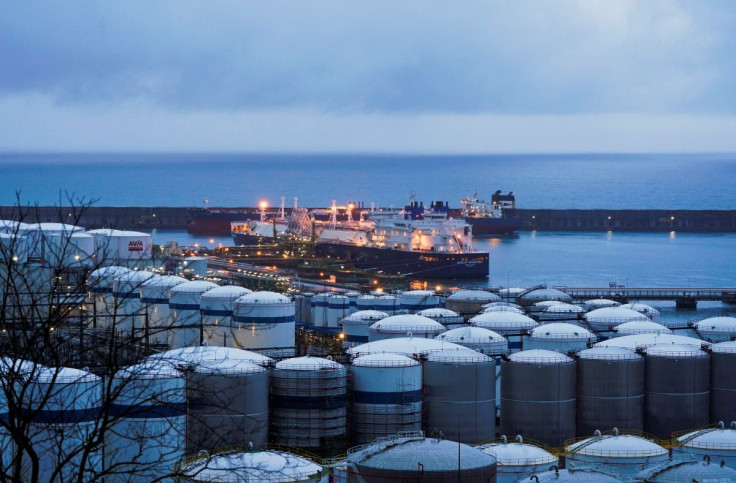Factbox-What Are Europe's Options In Case Of Russian Gas Disruption?

European gas prices have risen as sanctions on Russia have been tightened over its invasion of Ukraine and amid fears of supply disruptions.
Earlier this week, Russian Deputy Prime Minister Alexander Novak said Russia was fulfilling its gas supply obligations but that it would be entirely within its rights to retaliate against the European Union after Germany last month froze the certification of the Nord Stream 2 gas pipeline.
The arrival of Russian troops at two gas compressor stations in eastern Ukraine poses a risk to European supplies, Ukraine's gas pipeline operator warned on Thursday, but there were no signs of an immediate impact on flows.
HOW RELIANT IS EUROPE ON RUSSIAN GAS?
Europe depends on Russia for about 40% of its natural gas, with most transported by pipeline. Rystad Energy estimates 52 billion cubic metres (bcm) of gas a year comes to Europe via Ukraine or nearby routes, while total Russian supplies to Europe are about 150 bcm to 190 bcm.
Some pipelines transit Ukraine, while others take alternative routes, such as Yamal-Europe, which crosses Belarus and Poland to Germany, and Nord Stream 1, which runs under the Baltic Sea to Germany.
Most European countries have cut reliance on Russian gas in recent years. In 2021, the Ukraine transit corridor was mainly used for gas going to Slovakia and then to Austria and Italy.
U.S. President Joe Biden this week imposed an immediate ban on Russian oil and other energy imports and Britain said it would phase out imports through the end of 2022.
Other countries are trying to wean themselves off Russian gas. The EU has said it wants to cut Russian gas by two-thirds this year and end its reliance on Russian supplies "well before 2030".
WHERE ELSE CAN EUROPE GET SUPPLY FROM?
Some countries have alternative supply options and Europe's gas network is linked up so supplies can be shared, although the global gas market was tight even before the Ukraine crisis.
Germany, Europe's biggest consumer of Russian gas which has halted certification of the new Nord Stream 2 gas pipeline from Russia because of the Ukraine crisis, could import gas from Britain, Denmark, Norway and the Netherlands via pipelines.
Norway's Equinor said it is considering ways to produce more gas from its Norwegian fields during the upcoming summer in Europe, a season in which output is normally affected by maintenance.
Southern Europe can receive Azeri gas via the Trans Adriatic Pipeline to Italy and the Trans-Anatolian Natural Gas Pipeline (TANAP) through Turkey.
The United States, which exports shipments of liquefied natural gas (LNG), has also sought to help Europe by asking LNG producers at home and abroad to ramp up supplies.
LNG imports to northwest Europe, including from the United States, have hit record highs this year.
But Qatar, one of the world's top LNG producers, has said no single country can replace Russian supplies to Europe, with most volumes tied to long-term supply contracts.
Europe's LNG terminals also have limited capacity for extra imports, although some European countries say they are looking at ways to expand imports and storage.
Britain, which is much less reliant on Russian gas than its European neighbours, has said it will look at all options to boost energy supplies.
ARE THERE OTHER OPTIONS TO COPE WITH A GAS SUPPLY CRUNCH?
Several nations could seek to fill any gap in energy supplies by turning to electricity imports via interconnectors from neighbouring states or by boosting power generation from nuclear, renewables, hydropower or coal.
The European Commission said this week that gas and LNG from countries like the United States and Qatar could this year replace 60 billion cubic metres (bcm), of the gas Europe gets annually from Russia. By 2030, increased biomethane and hydrogen use could also help.
New wind and solar projects could replace 20 bcm of gas demand this year, while tripling capacity by 2030, adding 480GW of wind and 420 GW of solar energy, could save 170 bcm a year.
Turning down thermostats by 1?C could save an extra 10 bcm this year, while by 2030, replacing gas boilers with 30 million heat pumps could save 35 bcm, the Commission added.
Nuclear availability is falling in Belgium, Britain, France and Germany as plants are facing outages as they age or are decommissioned or phased out.
Europe has been trying to shift away from coal to meet climate targets but some coal plants have been switched back on since mid-2021 because of surging gas prices.
Germany has said it could extend the life of coal or nuclear plants to cut reliance on Russian gas.
The head of a gas lobby said Germany could increase its domestic production at fields concentrated in the north of the country.
In past crises, countries have also sought to reduce industrial production at certain times, pay back-up generators to switch on supply, order households to curtail energy use or enforce temporary power cuts.
A spike in electricity prices has forced small German steelmaker Lech-Stahlwerke to halt production at its plant in Bavaria, the German state's only steel works.
Norwegian fertiliser-maker Yara is also curtailing its ammonia and urea output in Italy and France.
HAS SUPPLY TO EUROPE BEEN DISRUPTED BEFORE?
The last 15 years have seen several disputes between Russia and Ukraine over gas, mostly to do with prices paid.
In 2006, Gazprom cut supplies to Ukraine for one day. In the winter of 2008/2009, Russian supply disruptions rippled across Europe. Russia cut off supplies to Kyiv in 2014 after Moscow annexed Crimea.
Ukraine stopped buying Russian gas in November 2015 and has instead imported gas from EU countries, by reversing the flow in some of its pipelines.
© Copyright Thomson Reuters 2024. All rights reserved.




















